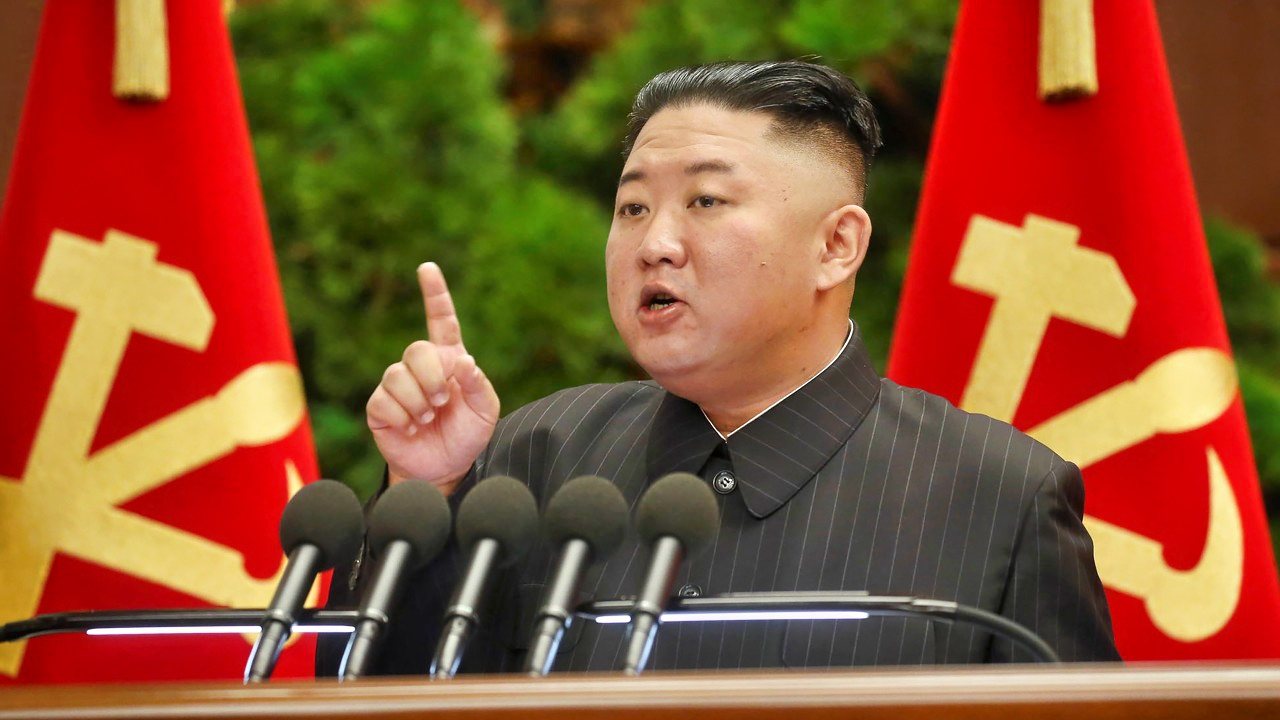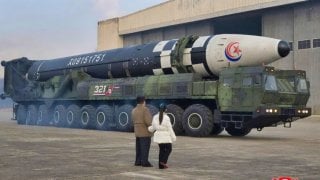Is North Korea Really Getting Ready for a War Against America?
So, what is Kim Jong-un trying to accomplish? Kim apparently has a longer-term plan that could explain his 2024 provocations, nuclear weapon production, and threats of war.
In late-2023, the South Korean National Intelligence Service warned that North Korea was likely “to engage in unexpected military and cyber provocations” in 2024. Then, North Korean leader Kim Jong-un told his people “to prepare for war with the U.S.” in 2024.
Is Kim planning to escalate his cold war on the United States and its allies to a hot war?
Only if doing so serves the “two consistent missions given to the military by the Kim family regime: preserve the North Korean state’s independent existence against any external power, and provide the means for North Korea to dominate the Korean Peninsula.”
But the United States has no intention of attacking North Korea: It has very little to gain and a lot to lose by engaging in war with North Korea. And it has made this attitude abundantly clear for decades by both saying so directly and avoiding potentially escalatory reactions to North Korean military attacks and provocations, fearing North Korean escalation.
So, what is Kim Jong-un trying to accomplish? Kim apparently has a longer-term plan that could explain his 2024 provocations, nuclear weapon production, and threats of war. Several years ago a leaked North Korean document for training senior military personnel described the North Korean plan’s objectives:
The dear supreme commander [Kim] will dominate the world with the nuclear weapons, will make the U.S. apologize and compensate us for decades of bullying our people, and will declare to the entire world that the world’s powerful order will be reshaped by the Juche-Korea, not the United States.
Yes, these objectives sound extreme. How might Kim try to achieve these long-term objectives?
North Korea would not need to become a U.S. nuclear weapon peer to leverage the United States. Consider a future in which North Korea has, say, 300 nuclear weapons and 100 ICBMs armed with nuclear weapons, something that may be possible within 10 years. With such a force, he could overwhelm currently planned U.S. homeland missile defenses and threaten one or more U.S. cities with nuclear attack if the United States does not repeal its sanctions against North Korea. If the United States refuses and Kim does attack U.S. cities, he could then threaten to destroy many more U.S. cities if the United States retaliates with nuclear weapons. Would a U.S. president take such a chance?
Kim could also threaten the United States with a limited nuclear attack unless it abandons its alliance with the ROK. And he could demand that the United States disengage from countries like Ukraine that the United States would be supporting against Russian or Chinese aggression. If Kim succeeds in such actions because the ROK/U.S. are afraid of escalation, wouldn’t the world order be radically reshaped by North Korea?

And regardless of what the U.S. president would do, what does Kim believe would happen? Does Kim feel that he would be in a position of real leverage given the passive U.S. reactions to North Korean provocations and his continued building of nuclear weapons and delivery means?
If Kim could leverage the United States, wouldn’t he also expect that he could leverage the ROK? For example, might he insist that the ROK pay him $100 billion per year and permanently discontinue producing K-pop, which Kim feels is a real threat to his regime? After all, wasn’t Kim already able to influence the former ROK President Moon Jae-in and his party to enact a law to stop ROK groups from sending leaflets into the North? Could North Korea reach a point where in effect it dominates the Korean Peninsula without requiring a hot war and all of the risks of “ideological contamination” of his personnel that such a war would pose?
And think: When Kim declared that he will exponentially increase his number of nuclear weapons and told his missile factories that they must “permanently expand production capacity,” Kim was clearly not just seeking 100 or so nuclear weapons. Why would he have his poor country expand production capacity if he only planned to use that capacity for one or two or three years to achieve a small nuclear force? How did the ROK/U.S. respond to these declarations?
To reach such leverage, in 2024 Kim will almost certainly continue provocations in which he launches theater and intercontinental ballistic missile tests, including tests of some new missiles. Kim is also escalating by threatening that “we have no intention of avoiding war if the Republic of Korea dares to attempt to use force against our country or threaten our sovereignty and security.” And Kim “warned he would have no hesitation in ‘annihilating’ South Korea.” In addition, Kim may launch ICBMs out over the Pacific, test one or more nuclear weapons underground or on a ballistic missile, carry out selective conventional force attacks against the ROK in which he threatens nuclear escalation if the ROK/U.S. retaliate (the North exercising its “nuclear shadow”), and continue production of nuclear weapons. The Kim family has historically conditioned the ROK/U.S. to accept escalating provocations and will almost surely continue to do so.
If Kim is seeking nuclear weapons to provide the coercive power and position to dominate the peninsula, why are the ROK and the U.S. avoiding responses to the North’s provocations which could lead to military escalation in the short-term? If North Korean confrontation with the ROK/U.S. is only a matter of time, isn’t it better for the ROK and the U.S. to confront Kim now when it is far less dangerous than when Kim has built a substantial nuclear weapon force?
That said, the vehemence of Kim’s latest threats suggests that he is also hoping that the ROK/U.S. will overreact to his threats of attack on and annihilation of the ROK. An overreaction would give him justification for some level of escalation, allowing him to claim that President Yoon is a warmonger putting the entire ROK at risk. Kim could do this hoping to undermine President Yoon’s party in the April National Assembly election.

Thus, the ROK and the U.S. need to take a deliberate and cautious approach. Because they have not really explained the hazards of North Korean nuclearization, they likely need to start with an information campaign to help their people understand why something must be done to rein-in North Korean nuclear weapon developments, its related provocations, and its threats despite the risks of doing so.
The ROK and the U.S. also need to develop plans for reining-in the North. For example, they might decide to seek an immediate freeze in North Korean nuclear weapon and ICBM production. These North Korean productions pose an existential threat to the ROK and the United States, justifying a response. To minimize escalation risks, they could use information, about which Kim seems to worry a great deal. That information might include clear descriptions of the lack of hostility by the ROK and the U.S. toward the North, why an invasion of the North by the a ROK and the U.S. makes no sense, and how Kim is wasting his people’s resources on building nuclear weapons and other military capabilities instead of feeding his people and providing them electricity, health care and other needs. The ROK and the U.S. could then openly offer to provide food, health resources, and electricity to North Korea if North Korea commits no provocations for six months.
There are other information options that the ROK and the U.S. could employ. For example, Kim’s sister, Kim Yo-jong, has recently claimed that ROK President Yoon’s policies have actually justified Pyongyang’s efforts to build nuclear weapons. Experts have called this, “an attempt to fan the flames of political division in South Korea.” The ROK could reply that Kim Jong-un’s provocations over the last couple of years that were designed to damage the ROK/US alliance have instead made the alliance much closer and brought Japan into a trilateral partnership. These outcomes demonstrate major failures of the Kim regime.
To make sure these messages reach especially the North Korean elites, the ROK and the U.S. may need to broadcast these messages from aircraft with fighter escorts operating over international waters off the east and west coasts of North Korea. The ROK and the U.S. may also decide to send high altitude balloons over the North to drop USB drives containing K-pop, K-dramas, and messages as discussed above. Even if the North destroys such balloons, many of the USB drives carried would likely be scattered over large areas in the North and become available to some of the North Korean people.
Because North Korean ballistic missiles pose an existential threat, the ROK and the U.S. could threaten Kim that each time he does a ballistic missile test, they will test one of their delivery systems that could pose an existential threat to Kim’s regime. These might include using Predator drones based in Japan to attack a simulated North Korean leadership target in the south of the ROK. According to one North Korean escapee, Kim particularly fears Predators because of their use to attack leadership targets in the Middle East. Or the United States could exercise a couple of fighter aircraft in the ROK that are capable of delivering tactical nuclear weapons.


